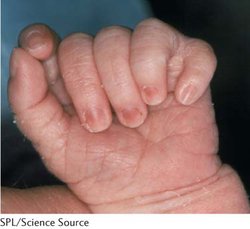Penetrance and Expressivity
In the genetic crosses presented thus far, we have assumed that every individual organism having a particular genotype expresses the expected phenotype. We have assumed, for example, that in peas, the genotype Rr always produces round seeds and the genotype rr always produces wrinkled seeds. For some characters, however, such an assumption is incorrect: the genotype does not always produce the expected phenotype, a phenomenon termed incomplete penetrance.
Incomplete penetrance is seen in human polydactyly, the condition of having extra fingers or toes (Figure 4.14). There are several different forms of human polydactyly, but the trait is usually caused by a dominant allele. Occasionally, people possess the allele for polydactyly (as evidenced by the fact that their children inherit the polydactyly), but nevertheless have a normal number of fingers and toes. In these cases, the gene for polydactyly is not fully penetrant. Penetrance is defined as the percentage of individuals having a particular genotype that express the expected phenotype. For example, if we examined 42 people having an allele for polydactyly and found that only 38 of them were polydactylous, the penetrance would be 38/42 = 0.90 (90%).

A related concept is that of expressivity, the degree to which a trait is expressed. In addition to exhibiting incomplete penetrance, polydactyly exhibits variable expressivity. Some polydactylous people possess extra fingers or toes that are fully functional, whereas others possess only a small tag of extra skin.
Incomplete penetrance and variable expressivity are due to the effects of other genes and environmental factors that can alter or completely suppress the effect of a particular gene. For example, a gene may encode an enzyme that produces a particular phenotype only within a limited temperature range (see also Environmental Effects on the Phenotype). At higher or lower temperatures, the enzyme does not function, and the phenotype is not expressed; the allele encoding such an enzyme is therefore penetrant only within a particular temperature range. Many characters exhibit incomplete penetrance and variable expressivity; thus, the mere presence of a gene does not guarantee its expression.  TRY PROBLEM 28
TRY PROBLEM 28
CONCEPTS
Penetrance is the percentage of individuals having a particular genotype that express the associated phenotype. Expressivity is the degree to which a trait is expressed. Incomplete penetrance and variable expressivity result from the influence of other genes and environmental factors on the phenotype.
 CONCEPT CHECK 7
CONCEPT CHECK 7
How does incomplete dominance differ from incomplete penetrance?
Incomplete dominance refers to alleles at the same locus; incomplete penetrance refers to alleles at different loci.
Incomplete dominance ranges from 0% to 50%; incomplete penetrance ranges from 51% to 99%.
In incomplete dominance, the heterozygote is intermediate between the homozygotes; in incomplete penetrance, heterozygotes express phenotypes of both homozygotes.
In incomplete dominance, the heterozygote is intermediate between the homozygotes; in incomplete penetrance, some individuals do not express the expected phenotype.
d